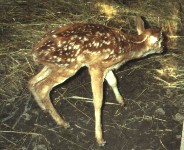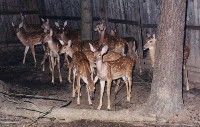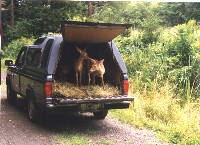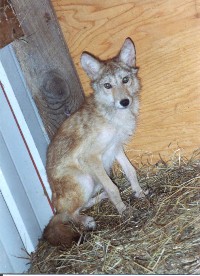




Here at the Center, White-tailed fawns make up the majority of our admissions. Most of the fawns we raise have been either orphaned or injured. We go to great lengths to make sure the baby deer are truly in need of our services, as nobody can raise a fawn as well as its mother (the doe). Before picking up a fawn, MAKE SURE IT HAS BEEN ORPHANED OR INJURED.
Don't assume because you don't see the mother, that a fawn has been abandoned. Does tend to put their babies in tall grasses for protection from predators. This could be in your backyard. If it isn't walking around "bleating", the mother is probably close by. Keep your dog(s) away from the area, as well as any humans, and the mother should return.
While hiking in the woods, you come across a fawn lying quietly on the forest floor, leave it alone, but notice how the spots of the fawn make it almost invisible in its surroundings.
If you have any questions about what to do, call a local wildlife rehabilitator. They can advise you on what steps to take to take to assure you are truly "rescuing" an animal in need, and not "kidnapping" a baby from its mother.

It is assumed that if you are looking for emergency information at this location that the animal in question is either in your possession or nearby where you can keep an eye on it. Don't forget to read the special instructions above on White-tailed Fawns. The first and most important thing to do at this point is to call a Wildlife Rehabilitator in your area. Your state division of wildlife management, your local veterinarian, area animal shelters, state or local
police or animal control officer should be able to supply you with information on how to contact them.
You can search the following for your state's government agencies:
http://www.searchgov.com/directory/
Your local Wildlife Rehabilitator will direct you on how to proceed.
There are some things you should do while contacting a Wildlife Rehabilitator.
Keep all animals (pets), people and children away from the animal in question. This means to confine pets in an area away from the afflicted animal. Groups of people standing around watching will overly stress an animal whose main defense is to flee from humans, diminishing its chance to survive.
If you must observe the animal, do so from a distance that does not upset it.
If you or anyone else is bitten or scratched when dealing with a wild animal you MUST immediately contact your area Health Department and report the incident.
Use common sense - We once had well-meaning people arrive at The Center with a full-grown doe that was struck by a truck and had sustained a broken back. The animal suffered greatly as it was driven all over creation in an enclosed pick up truck - about as far as you can get from her natural environment. She endured tremendous pain and stress and only could be humanely euthanized in the end. When you see an adult large mammal grievously injured, do not try to move it, but contact your local authorities (State Police, state wildlife management office, etc.) http://www.searchgov.com/directory/
or wildlife Rehabilitator for procedures.
As always, use common sense - don't approach an animal that is acting strangely or viciously.
Additionally, most Wildlife Rehabilitators do not respond to animal nuisance calls. These are handled by paid nuisance control professionals. Nuisance Animal Control professionals are generally listed in the Yellow Pages or through your state wildlife management department.
Do Not attempt to feed or water distressed animals or birds
without contacting a Wildlife Rehabilitator - The wrong food or improper watering can kill.
State and Federal Law requires special licenses and or permit(s) to rehabilitate wildlife. Always contact a Wildlife Rehabilitator when you take possession of a wild animal in distress.
THE WHITE-TAILED DEER - SOME INTERESTING FACTS
Believe it or not there are some 38 subspecies to the White-tailed deer family. Those in the northern ranges tend to be larger weighing as much as 430 pounds. While more southerly species are much smaller. The Florida Key deer usually weigh less than 55 pounds and whose low numbers have put them on the protected species lists. White-tailed deer are grayish brown in winter and reddish brown in summer. They have a white patch of fur under their tails and a white rump - this is where they get there name - and will raise their tails to show a white warning "flag" to others alerting them to flee.
The male White-tail or "buck" starts to grow antlers or "racks" in the spring and are fully developed at summers end. At this time they shed their "velvet", a thin covering of fur and skin covering the antlers, and proceed into the mating season or "rut". After the mating season or around mid-winter they loose or "shed" their antlers.
The female White-tail or "doe" remains antler-less. After the fall rut, she will give birth usually around May or June. If it is her first birth, she will generally have one baby or "fawn". Subsequent births will usually result in twins, however triplets and even quadruplets have been seen. Another factor for birth numbers is the availability of food, with drops in nutrition levels resulting in fewer births.
White-tailed deer are found in all habitats of the contiguous United States and Southern Canada. As people have encroached upon their habitat, White-tails have adapted to eating other types of vegetation, including ornamental plantings, and putting them at odds with people.
Like many other ungulates, deer are ruminants, having complicated digestive systems. This system is broken down into separate chambers, which contain microorganisms, which break down the vegetable matter they eat. They have the ability like a cow to regurgitate their food and "chew their cud", swallowing the material again for proper digestion.
White-tailed deer are "browsers" - eating shoots and leaves of woody plants, instead of grasses. They enjoy eating young plants, shoots and buds, a variety of leaves, shrubs, bark, berries and fruits.
Winter induces a lack of appetite in conjunction with the amount of available food. In severe winters a total lack of food supply will cause White-tails to eat thicker branches on trees usually up to the thickness of a pencil - usually they will eat branches up to the size of a wooden match stick - and as this disappears, they will strip bark from trees for food.
White-tailed deer live in small groups or alone. While taking care of their young, does will remain solitary. She will usually place her fawn in one area, moving away to hunt for browse in another. The fawn's camouflaged coat and virtually no scent - because of the mother's cleaning regiment - help to protect them from predators. When the fawns are old enough, does will group with other does and fawns. During the rut season, bucks are generally solitary, but will join with other bucks around mid-winter, forming bachelor groups. White-tails will mark their territory with scent glands and urine. Given chase or the desire, a White-tail can attain speeds 40 mph, and jump over 8 feet.

"What's that you hear?"
"Children of the night, what music they make!" a line from the popular sci-fi movie, "Dracula" starring the ever-famous Bela Lugosi, probably one of our first contacts with nocturnal carnivores. But the shrill cry of a coyote at night will sharpen the senses of any creature. We have received numerous calls on the subject with such interesting questions as "Will they attack a human?" or "Is my house safe?" or "Do they carry rabies?" and many more.
Yes, there are coyotes in the area. Yes, they do hunt for their food. Will they attack you? Probably not, but any warm blooded mammal can carry rabies.. Should you take precautions? Of course have your pet's shots kept up to date. Donít leave smaller pets outdoors alone, particularly after dark.
Use common sense. If you hear a coyote at night, donít go out looking for it. If you see one during daylight hours, give it a wide berth, it's not normal for them to be out in daylight. This could indicate rabies exposure, canine distemper, etc.
 Back to Center Main Page
Back to Center Main Page
 HOME
HOME
![]()